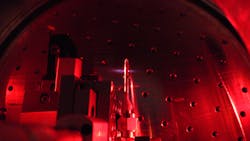ULTRAFAST SOURCES: 2.8 fs deep-UV pulses are spectroscopist's tool
Femtosecond and attosecond light pulses are now allowing scientists to deeply explore the workings of atoms, molecules, and nanoparticles. For example, few-cycle deep-ultraviolet (UV) pulses fired at molecules can manipulate valence-shell electrons, preparing the molecules for high-resolution study via attosecond spectroscopy.
Up to now, the shortest pulses created in the deep-UV range have been about 3.7 fs in duration (attosecond pulses consist of light at shorter extreme-UV wavelengths). But a direct-frequency-conversion approach developed by researchers at Max-Planck-Institut für Quantenoptik, Technische Universität München, and Ludwig-Maximilians-Universität (all of Garching, Germany) and King Saud University (Riyadh, Saudi Arabia) produces deep-UV pulses only 2.8 fs long, with pulses less than 1 fs a possibility.1
Frequency-tripling in neon
To create the pulses, focused sub-4-fs near-infrared (IR) laser pulses are frequency-tripled by passing them through a 3 mm long gas cell filled with neon at a pressure of 5 bar. The broadband 0.25 mJ IR pulses, which have a carrier wavelength of 750 nm and are polarized by a series of polymer pellicles placed at the Brewster angle, emerge as deep-UV pulses with an energy of 1.5 µJ. The much stronger exiting collinear IR radiation is filtered out via Brewster reflections from silicon mirrors, which also end up reducing the deep-UV pulse energy to about 300 nJ.
The gas cell, which is located in a vacuum chamber, is of a type called "quasi-static," meaning it has no windows. The gas emerges through two small holes in the cell; the focused IR laser beam enters and exits the cell through the holes.
Downstream, an autocorrelator with all-reflective optics (to eliminate any dispersion) is used to produce an autocorrelation trace of the pulses. The device, which includes an ion-mass spectrometer, relies on three-photon ionization of krypton (Kr) atoms. The deep-UV pulse is split and subjected to a variable delay; the variation in yield of Kr ions as a function of the delay corresponds to a fringe-resolved autocorrelation trace of the deep-UV pulses, producing a UV spectrum that reaches from about 230 to 300 nm with a peak energy of 263 nm.
The pulse length derived from the measurements is 2.8 fs, which matches well with the 2.5 fs Fourier limit that is calculated from the measured UV spectrum of the pulse.
Full control of electrons for spectroscopy
The researchers believe that efficient creation of superposition states in electrons' valence bands by these deep-UV pulses will, for the first time, enable launching of valence-electron wavepackets in neutral molecules, which, along with the absence of strong near-IR light, will aid in time-resolved absorption or photoelectron spectroscopy of these molecules.
"We have not explored the full potential of our approach despite these encouraging first steps," says Eleftherios Goulielmakis, the lead researcher. "Currently, we are working on the possibility of creating even broader UV spectra utilizing nonlinear dynamics of a near-single-cycle laser pulse in such a gas cell. Such spectra could support even subfemtosecond pulses in this spectral range. The first results look very promising, and therefore we are hopeful that this technology will soon take a key role, along with extreme-UV attosecond pulses, in the full control of electrons at the nanoscale."
REFERENCE
1. F. Reiter et al., Opt. Lett. 35, 13, p. 2248 (Jul. 1, 2010).
About the Author
John Wallace
Senior Technical Editor (1998-2022)
John Wallace was with Laser Focus World for nearly 25 years, retiring in late June 2022. He obtained a bachelor's degree in mechanical engineering and physics at Rutgers University and a master's in optical engineering at the University of Rochester. Before becoming an editor, John worked as an engineer at RCA, Exxon, Eastman Kodak, and GCA Corporation.

